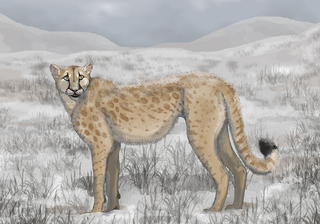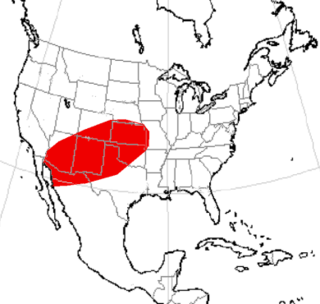
Felidae is the family of mammals in the order Carnivora colloquially referred to as cats. A member of this family is also called a felid. The term "cat" refers both to felids in general and specifically to the domestic cat.

Proailurus is an extinct felid genus that lived in Europe and Asia approximately 25-30.8 million years ago in the Late Oligocene and Miocene. Fossils have been found in Mongolia, Germany, and Spain.

Pseudaelurus is a prehistoric cat that lived in Europe, Asia and North America in the Miocene between approximately twenty and eight million years ago. It is considered to be a paraphyletic grade ancestral to living felines and pantherines as well as the extinct machairodonts (saber-tooths), and is a successor to Proailurus. It originated from Eurasia and was the first cat to reach North America, when it entered the continent at about 18.5 Ma ending a 'cat-gap' of 7 million years. The slender proportions of the animal, together with its short, viverrid-like legs, suggest that it may have been an agile climber of trees.
Metailurini is an extinct taxonomic tribe of large saber-toothed cats that lived in Africa, Asia, Europe, and North America from the Miocene to the Pleistocene.

Miracinonyx is an extinct genus of felids belonging to the subfamily Felinae that was endemic to North America from the Pleistocene epoch and morphologically similar to the modern cheetah, although its apparent similar ecological niches have been considered questionable due to anatomical morphologies of the former that would have crippled any ability to run as fast. The genus was originally known from fragments of skeletons, but nearly complete skeletons have been recovered from Natural Trap Cave in northern Wyoming.

Adelphailurus is an extinct genus of metailurin machairodontine (saber-toothed) cat that inhabited western North America during the middle Pliocene. It is monotypic, containing only the species Adelphailurus kansensis.

The John Day Formation is a series of rock strata exposed in the Picture Gorge district of the John Day River basin and elsewhere in north-central Oregon in the United States. The Picture Gorge exposure lies east of the Blue Mountain uplift, which cuts southwest–northeast through the Horse Heaven mining district northeast of Madras. Aside from the Picture Gorge district, which defines the type, the formation is visible on the surface in two other areas: another exposure is in the Warm Springs district west of the uplift, between it and the Cascade Range, and the third is along the south side of the Ochoco Mountains. All three exposures, consisting mainly of tuffaceous sediments and pyroclastic rock rich in silica, lie unconformably between the older rocks of the Clarno Formation below and Columbia River basalts above.

Barbourofelidae is an extinct family of carnivorans of the suborder Feliformia, sometimes known as false saber-toothed cats, that lived in North America, Eurasia and Africa during the Miocene epoch and existed for about 7.9 million years. Thought to be an independent lineage from the Nimravidae and Machairodontinae, which had all attained elongated canines, recent research argues that it may be a subfamily of the Nimravidae, extending its biochronological range into the Miocene, although this issue is not yet fully resolved.

Nimravides is a genus of extinct saber-toothed cats that lived in North America during the Late Miocene, between 10.3 and 5.332 Ma. Despite its scientific name, Nimravides does not belong to the Nimravidae, but is a true cat belonging to the family Felidae.
?Oryzomys pliocaenicus is a fossil rodent from the Hemphillian of Kansas, central United States. It is known from a single mandible with the back part missing. All three molars are present, but very worn. Together, the molars are 3.6 mm long. The fossil was discovered in 1935 and described in 1939 as a possible species of Oryzomys. Later authors doubted this allocation and suggested that it may instead belong in Bensonomys or Jacobsomys, but the material may not allow a definite identification.

James Lloyd Patton, is an American evolutionary biologist and mammalogist. He is emeritus professor of integrative biology and curator of mammals at the Museum of Vertebrate Zoology, UC Berkeley and has made extensive contributions to the systematics and biogeography of several vertebrate taxa, especially small mammals.
The Valentine Formation is a geologic unit formation or member within the Ogallala unit in northcentral Nebraska near the South Dakota border. It preserves fossils dating to the Neogene period and is particularly noted for Canid fossils. A particular feature of the Valentine is lenticular beds of green-gray opaline sandstone that can be identified in other states, including South Dakota, Nebraska, Kansas, and Colorado. Even though three mammalian fauna stages can be mapped throughout the range of the Ogallala, no beddings of the Ogallala are mappable and all attempts of formally applying the Valentine to any mappable lithology beyond the type location have been abandoned. Even so, opaline sandstone has been used to refer to the green-gray opalized conglomerate sandstone that is a particular feature of the lower Ogallala.
The Sharps Formation is a geologic formation in South Dakota. It preserves fossils dating back to the Paleogene.
Styriofelis is an extinct genus of Felidae known from the Miocene of Europe.
Hyperailurictis is an extinct genus of felid from Miocene North America. The Hyperailurictis species are Pseudaelurus-grade felids and thought to be the first felids in the Americas.
Miopanthera is an extinct genus of Pseudaelurus-grade felids.
Sivaelurus is a fossil genus of felid containing only a single species, S. chinjiensis, which was described based on a partial right maxilla collected from the Chinji Formation in the Lower Siwaliks. The species was originally described by Guy Ellcock Pilgrim as Pseudaelurus chinjiensis in 1910, who later erected a new genus, Sivaelurus, for it in 1913.
Asilifelis is an extinct genus of small felid that lived in what is now Kenya during the Early Miocene. Despite its fragmentary remains, it is remarkable because of its small size and advanced dentition. It contains a single species, Asilifelis cotae.








